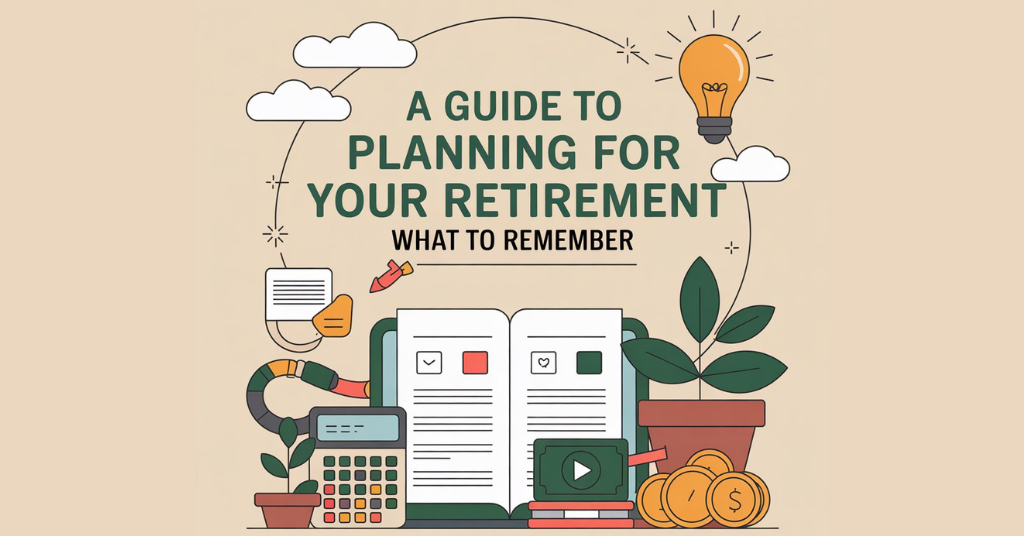Retirement is one of the most important phases of life, and planning for it requires careful thought and preparation. In Australia, retirement planning isn’t just about saving money—it’s about creating a secure, comfortable, and stress-free future. With superannuation, the Age Pension, personal savings, and investments forming the backbone of retirement finances, knowing how to plan is critical. This is A Guide to Planning for Your Retirement What to Remember, with examples, calculations, and actionable tips.
Understanding the Australian Retirement System
Australia has a structured retirement system designed to support citizens financially after they stop working. It mainly includes:
- Superannuation (Super):
Super is a government-mandated savings scheme. Employers contribute a portion of your salary into a super fund, which is invested on your behalf. As of July 1, 2025, the Superannuation Guarantee (SG) rate will rise to 12%. Contributions can also include voluntary payments from your salary (salary sacrifice) or personal contributions.
Example: If your annual salary is AUD 80,000, your employer will contribute AUD 9,600 annually (12%) to your super. - Age Pension:
The Age Pension provides a government-supplied income for eligible Australians aged 67 and over. The pension is subject to means testing based on your assets and income. It acts as a safety net if your super and personal savings are insufficient to fund your retirement.
Example: A single retiree with assets below the threshold may receive AUD 27,000 per year from the government. - Personal Savings and Investments:
Beyond super, you can build a retirement nest egg through savings, property, shares, managed funds, and bonds. These provide additional income and financial flexibility in retirement.
A Guide to Planning for Your Retirement What to Remember
💡 1: Define Your Retirement Goals
Before crunching numbers, think about how you want your retirement to look:
- Lifestyle: Will you travel, dine out regularly, pursue hobbies, or volunteer?
- Housing Needs: Do you plan to own your home outright, downsize, or rent?
- Healthcare Requirements: Consider long-term care, health insurance, or ongoing medical expenses.
- Family Support: Will you help children, grandchildren, or elderly parents financially?
Example: If you plan to travel twice a year internationally, budget AUD 10,000 annually for flights, accommodation, and activities.
💰 2: Estimate Your Retirement Expenses
A detailed estimate of your retirement expenses helps determine how much you need to save. Categories to consider:
- Essential Living Costs: Rent/mortgage, utilities, groceries, transport.
- Healthcare Costs: Private health insurance, out-of-pocket medical expenses.
- Lifestyle Expenses: Travel, hobbies, entertainment, eating out.
- Unexpected Costs: Emergency funds for repairs, health emergencies, or other contingencies.
Example Calculation:
Let’s assume:
- Current monthly expenses: AUD 4,000
- Annual inflation: 3%
- Years until retirement: 25
Future monthly expenses can be calculated using the formula:
Future Expenses = Current Expenses × (1 + Inflation Rate) ^ Years
- AUD 4,000 × (1 + 0.03)^25 ≈ AUD 8,150 per month
Thus, your estimated annual retirement expenses: AUD 97,800
🏦 3: Assess Your Current Financial Position
Take stock of your current assets and liabilities:
- Super Balance: Check regularly and review fund performance.
- Personal Savings: Bank accounts, term deposits, and emergency funds.
- Investments: Shares, property, managed funds, or bonds.
- Debts: Mortgages, personal loans, credit cards, and any other liabilities.
Example:
- Super: AUD 200,000
- Personal savings: AUD 50,000
- Investments: AUD 100,000
- Debts: AUD 50,000
Net assets = AUD 300,000
Compare this to your target retirement corpus to identify the savings gap.
📈 4: Develop a Savings and Investment Strategy
A well-diversified investment strategy ensures growth and reduces risks.
- Maximise Super Contributions: Salary sacrifice boosts your retirement savings and can reduce tax.
- Diversify Investments: Mix shares, bonds, ETFs, property, and other assets to balance risk and returns.
- Consider Investment Time Horizon: Younger Australians can invest more aggressively (more equities) while older Australians may prefer conservative investments (bonds, fixed income).
- Monitor Performance: Regularly review fees, returns, and fund performance.
Example: Contributing AUD 5,000 annually to your super from age 35 to 65, assuming an average return of 6% p.a., would grow to approximately AUD 500,000.
🧾 5: Account for Inflation and Taxes
Inflation erodes purchasing power, so your investments must outpace inflation. Taxes on super withdrawals and investments can also reduce net income. Planning ahead ensures sufficient income in retirement.
Example: If you expect AUD 100,000 annual expenses and inflation averages 3% over 25 years, your future expenses: AUD 100,000 × (1.03)^25 ≈ AUD 209,000 annually.
🛡️ 6: Plan for Healthcare and Insurance
Healthcare is a major retirement cost:
- Private Health Insurance: Covers medical services not fully covered by Medicare.
- Long-Term Care Insurance: Helps with nursing home or assisted living expenses.
- Critical Illness Insurance: Provides lump-sum payment for serious conditions.
Example: Premiums of AUD 3,000/year for private health insurance over 20 years = AUD 60,000
📝 7: Estate Planning
Proper estate planning ensures your assets are distributed according to your wishes:
- Draft a Will: Clearly outline beneficiaries.
- Set Up Powers of Attorney: For financial and medical decisions.
- Establish Trusts if Needed: For complex estates or tax planning.
Example: Without a valid will, your estate may be distributed according to state laws, potentially causing disputes.
🔄 8: Review and Adjust Regularly
Life is dynamic. Career changes, health issues, or family events require adjusting your retirement plan.
- Annual Review: Check progress and update assumptions.
- Adjust Contributions: Increase savings when income rises.
- Seek Financial Advice: Professional advice ensures your plan remains on track.
Example: If you receive a pay rise of AUD 5,000, allocating AUD 2,500 extra to your super improves your retirement corpus by AUD 200,000 over 20 years (assuming 6% return).
📊 Case Study: John’s Retirement Plan
Profile: 40-year-old Australian aiming to retire at 65
- Desired annual income: AUD 80,000
- Current super: AUD 150,000
- Annual contributions: AUD 10,000
- Expected annual return: 6%
Projection: Using compound interest, his super would grow to approximately AUD 800,000 by retirement. Combined with personal savings of AUD 200,000, John meets his retirement target of AUD 1 million for a comfortable lifestyle.
Also Check: Guide Retirement Planning 30s: An Australian Perspective
💡 Additional Tips for Australian Retirees
- Downsize Your Home: Free up equity for investments or travel.
- Consider Part-Time Work: Maintains income and social engagement.
- Leverage Government Programs: Age Pension, Seniors Card discounts, and health rebates.
- Stay Financially Informed: Attend seminars, read financial news, or consult advisers.
🧠 Conclusion
Retirement planning in Australia requires careful consideration of superannuation, the Age Pension, personal savings, and investment strategies. By defining your goals, estimating expenses, diversifying investments, planning for healthcare, and reviewing your plan regularly, you can achieve financial security and enjoy a fulfilling retirement.
The key is to start early, remain disciplined, and adjust your strategy as life circumstances change. Retirement isn’t just about saving money—it’s about securing peace of mind, freedom, and comfort in your golden years.



